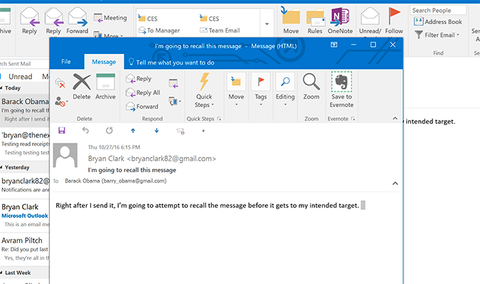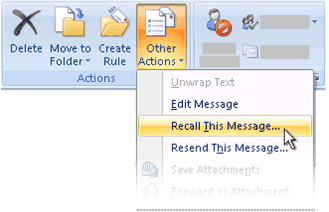

#Outlook recall email how to
If a mistake is made once or twice, quickly recall the email using the steps above and all is well.See also: How to add email signature in Outlook The best practice here is to reread the messages before they’re sent. This can get quite annoying and is unprofessional. If the e-mail has already been read, the account holder will be notified you are asking for a recall of the message. Outlook recall is a great feature but be sure not to overuse it. After deleting, a new little message will display above the message details indicating an attempt was made to recall the message.Ī successful recall results in a message deliver similar to the following two images: If the final checkmark is selected, which it is by default, of “Tell me if recall succeeds or fails for each recipient”, a message will be delivered to your Inbox specifying the success or failure of the recall. This is where you’d make the corrections you missed the first time around. Select the second bubble option of “Delete unread copies and replace with a new message” to do just that: Replace the message with a new one.

Choose “Delete unread copies of this message” to simply remove the message from the remote account. Toward the top, choose the “Actions” dropdown and select “Recall This Message…”Ī prompt will display with additional options. How do we do this? Begin by going back to the sent item, opening it in it’s full, maximized window. So an email has been sent and now it needs to be removed from the other account’s Inbox. Take note that if an email is sent outbound from Outlook to a Gmail account, this feature will not work because now we’re in the same boat as Yahoo!, with different servers being involved. The email never actually leaves the Exchange server but rather changes from one account to another. Outlook’s recall feature, by similar design, can only work in a local Exchange environment. It’s behind the firewalls and servers of Yahoo! – untouchable by any other service. When messages send out from Gmail’s servers, for example, and land on a Yahoo! account, the message is now no longer accessible from Gmail. Though this may work, it’s not as successful or discrete as Outlook’s recall. At this point, the only available option is to actually ask the user to not read the e-mail. Sadly, this feature isn’t available for email accounts like this. A message is sent to an address and moments later you decide you shouldn’t have sent it and want to recall it. Let’s say we’re using a Verizon email account. This sounds great, right? Why not just use Outlook for all your e-mails and never have to worry about falsely sending another message? With Outlook’s recall feature, and under an Exchange environment, messages can be requested for deletion after being sent. Microsoft Outlook has a built-in feature for removing, or recalling sent messages. Fortunately, digital word is a little different.

Harmful or untruthful words may come out that you don’t actually mean and there isn’t anything you can do about it in words. Regretting a sent e-mail message can result in embarrassment similar to speaking too soon.


 0 kommentar(er)
0 kommentar(er)
